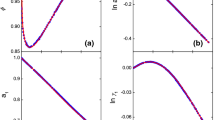Abstract
An analysis of techniques used for the determination of the free energy of the transport of an individual ion out of water into an aprotic solvent shows that the most reliable technique at present seems to be a method based on the determination of potentials relative to a cobalticenium electrode in combination with the energy required for the transport of the cobalticenium ion calculated after Born. This method is combined with relevant original and literature data to determine the transport energies for more than thirty ions out of water into propylene carbonate, dimethyl sulfoxide, dimethylformamide, acetonitrile, and acetone. The solubility of anhydrous sodium acetate in the above solvents are measured and the obtained data are used to determine the transport energies for the acetate ion and a neutral molecule of acetic acid. It is shown that, because of a large contribution of short-range interactions, especially the hydrogen bonds, the energies in question cannot be calculated with the aid of continuum electrostatics. This proves that the purely electrostatic method, which has been extensively used in biophysics for calculating pK of acid groups of proteins, is fallacious.
Similar content being viewed by others
REFERENCES
Pleskov, V.A., Zh. Fiz. Khim., 1940, vol. 14, p. 1477.
Pleskov, V.A., Usp. Khim., 1947, vol. 16, p. 254.
Koepp, H.M., Wendt, H., and Strehlow, H., Z. Electrochem., 1960, vol. 64, p. 483.
Gritzner, G., Inorg. Chim. Acta, 1977, vol. 24, p. 5.
Grunwald, E., Baughman, J., and Kohnstam, G., J. Am. Chem. Soc., 1960, vol. 82, p. 5801.
Arnett, E.M. and McKelvey, D.R., J. Am. Chem. Soc., 1966, vol. 88, p. 2598.
Parker, A.J. and Alexander, R., J. Am. Chem. Soc., 1968, vol. 90, p. 3313.
Krishtalik, L.I., Alpatova, N.M., and Ovsyannikova, E.V., Elektrokhimiya, 1990, vol. 26, p. 436.
Coetzee, J.F. and Sharpe, W.P., J. Phys. Chem., 1971, vol. 75, p. 3141.
Parker, A.J. and Alexander, R., J. Am. Chem. Soc., 1968, vol. 90, p. 3313.
Senda, M. and Takahashi, R., Rev. Polarogr., 1974, vol. 20, p. 56.
Kakutani, T., Joshikazu, M., and Senda, M., Bull. Chem. Soc. Jpn., 1978, vol. 51, p. 2847.
Madec, C. and Courtot-Coupez, J., J. Electroanal. Chem., 1977, vol. 84, p. 177.
Krishtalik, L.I., Alpatova, N.M., and Ovsyannikova, E.V., Elektrokhimiya, 1990, vol. 26, p. 429.
Krishtalik, L.I., Alpatova, N.M., and Ovsyannikova, E.V., Electrochim. Acta, 1991, vol. 36, p. 435.
Bunakova, L.V., Topolev, V.V., Khanova, L.A., and Krishtalik, L.I., Elektrokhimiya, 2004, vol. 40, p. 913.
Gritzner, G., J. Phys. Chem., 1986, vol. 90, p. 5478.
Krishtalik, L.I., Alpatova, N.M., and Ovsyannikova, E.V., Elektrokhimiya, 1995, vol. 31, p. 871.
Vorotyntsev, M.A. and Kornyshev, A.A., Elektrostatika sred s prostranstvennoi dispersiei (The Electrostatics of Spatial Dispersion Media), Moscow: Nauka, 1993.
Alpatova, N.M., Ovsyannikova, E.V., and Krishtalik, L.I., Elektrokhimiya, 1991, vol. 27, p. 931.
Marcus, Y., Kamlet, M.J., and Taft, R.W., J. Phys. Chem., 1988, vol. 92, p. 3613.
Gritzner, G., Electrochim. Acta, 1998, vol. 44, p. 73.
Marcus, Y., Electrochim. Acta, 1998, vol. 44, p. 91.
Weiner, S.J., Kollman, P.A., Case, D.A., et al., J. Am. Chem. Soc., 1984, vol. 106, p. 765.
Nicholls, A. and Honig, B., J. Comput. Chem., 1991, vol. 12, p. 435.
Mertts, E.L., Private communication.
Alexander, R. and Parker, A.J., J. Am. Chem. Soc., 1967, vol. 89, p. 5549.
Spravochnik khimika (A Chemist’s Handbook), Nikol’skii, B.P., Ed., Moscow: Khimiya, 1965, vol. III.
Akhadov, Ya.Y., Dielektricheskie parametry chistykh zhidkostei (Dielectric Properties of Pure Liquids), Moscow: Mosk. Aviats. Inst., 1999.
Zielinska, J., Makowski, M., Maj, K., Liwo, A., and Chmurzynski, L., Anal. Chim. Acta, 1999, vol. 401, p. 317.
Clare, B.W., Cook, D., Ko, E.C.F., Mac, Y.C., and Parker, A.J., J. Am. Chem. Soc., 1966, vol. 88, p. 1911.
Author information
Authors and Affiliations
Corresponding author
Additional information
Translated from Elektrokhimiya, Vol. 41, No. 3, 2005, pp. 325–332.
Original Russian Text Copyright © 2005 by Bunakova, Khanova, Krishtalik.
Rights and permissions
About this article
Cite this article
Bunakova, L.V., Khanova, L.A. & Krishtalik, L.I. Energies of transport of individual ions out of water into aprotic solvents: Specific features of the acetate ion transport. Russ J Electrochem 41, 287–293 (2005). https://doi.org/10.1007/s11175-005-0064-5
Received:
Issue Date:
DOI: https://doi.org/10.1007/s11175-005-0064-5




